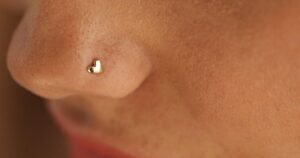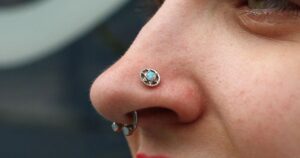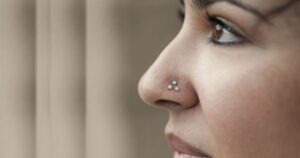Nose piercing is a form of body modification where a hole is made in the nose to insert jewelry. It’s a popular practice in many cultures and often symbolizes beauty or social status. The most common types include nostril and septum piercings. Care is needed to prevent infection and promote healing.
Struggling with a nose piercing that won’t go back in can be frustrating and painful. Whether it’s a new piercing or an old one that closed up, it’s important to address the issue promptly to avoid further complications. Don’t let this small setback ruin your piercing experience.
There are a few reasons why your nose piercing won’t go back in. The hole might have partially closed, especially if the jewelry has been out for a while. Swelling or infection can also make reinserting the jewelry difficult. Using the wrong technique or jewelry can cause issues too. For more detailed guidance, it’s best to consult a professional piercer.
When to Consult a Professional

Knowing when to consult a professional is crucial for the health of your nose piercing. If you notice signs of infection such as redness, swelling, pain, or discharge, it’s important to seek help immediately. An experienced piercer or healthcare provider can assess the situation, provide appropriate treatment, and give advice on how to care for your piercing to prevent further issues. Additionally, if you’ve tried to reinsert your nose piercing multiple times without success, a professional can help ensure the process is done safely and correctly, avoiding potential damage to the piercing site.
Persistent pain or difficulty reinserting jewelry is another clear indicator that professional assistance is needed. Attempting to force the jewelry back in can cause trauma to the tissue, leading to more serious complications. A trained piercer can use the right tools and techniques to reinsert the jewelry with minimal discomfort. They can also advise on whether a different type or size of jewelry might be more suitable for your piercing, helping to prevent future problems.
Signs of Infection
Signs of infection in a nose piercing include persistent redness and swelling around the piercing site, pain that doesn’t subside, and the presence of yellow or green discharge with a foul odor. You might also experience warmth around the area, increased tenderness, and sometimes even fever. If you notice any of these symptoms, it’s important to clean the piercing with saline solution and consult a healthcare professional or experienced piercer for proper treatment to prevent the infection from worsening.
Persistent Pain or Swelling
Persistent pain or swelling around a nose piercing is often a sign that something isn’t right and should not be ignored. This can occur due to various reasons, such as an infection, an allergic reaction to the jewelry, or trauma to the piercing site. If you experience ongoing discomfort or notice redness and swelling that doesn’t subside, it’s crucial to seek advice from a professional piercer or a healthcare provider. They can assess the situation, recommend appropriate treatments, and help prevent further complications. Proper aftercare and using high-quality jewelry are essential to minimize these risks.
nose ring will only go in halfway
Having a nose ring that will only go in halfway can be frustrating and uncomfortable. This issue often occurs because the piercing hole has started to close, making it difficult for the jewelry to pass through completely. It can also be caused by swelling or inflammation, which narrows the piercing channel and prevents the jewelry from sliding in smoothly. To address this, gently clean the piercing site with a saline solution to reduce any swelling and soften the tissue. Applying a small amount of water-based lubricant to the jewelry can help ease it back into place without causing further irritation.
If you continue to struggle with reinserting the nose ring, it’s important to avoid forcing it, as this can cause damage to the piercing and increase the risk of infection. Instead, seek assistance from a professional piercer who can assess the situation and provide the appropriate care. They can often reinsert the jewelry using specialized tools and techniques, minimizing discomfort and preventing complications. Regular cleaning and proper aftercare are crucial to maintaining the health of your piercing and ensuring that issues like this do not arise in the future.
how to reopen a closed nose piercing at home
Reopening a closed nose piercing at home requires patience and proper technique to avoid pain or infection. Start by washing your hands thoroughly and disinfecting the area around the piercing with saline solution or antiseptic. Gently massage the skin around the piercing to soften any scar tissue. Use a clean, sharp-ended jewelry piece or a sterilized needle to find the original piercing hole, applying light pressure and rotating it gently. If you encounter resistance or pain, stop immediately to avoid causing injury.
If the hole has only partially closed, you might be able to reinsert the jewelry with some effort. Using a lubricant like petroleum jelly can make this process easier. Slowly and carefully insert the jewelry, ensuring it follows the original piercing track. If you’re unable to reinsert it after several attempts or if the area becomes swollen or red, it’s best to seek help from a professional piercer. They have the tools and expertise to reopen the piercing safely and effectively.
how to find nose piercing hole from inside
Finding the nose piercing hole from inside involves a few simple steps. First, wash your hands thoroughly to avoid introducing bacteria. Next, gently press around the nostril area where you remember the piercing was placed. You might feel a slight indentation or bump, indicating the location of the hole. Using a clean, well-lit mirror can also help you visualize the area better. If the hole has partially closed, it may appear as a small opening or might be more challenging to detect. In such cases, gently inserting a thin, sterilized object like a sterile earring stud or a piercing taper can help locate the hole by feeling for resistance or a pathway.
Once you’ve located the hole, take care not to force anything through it. If you encounter resistance or cannot find the hole easily, it’s advisable to seek assistance from a professional piercer. They can use specialized tools and techniques to safely locate and reopen the piercing hole, ensuring minimal discomfort and reducing the risk of complications.nose piercing come out Remember, patience and gentleness are crucial when trying to find or reopen a nose piercing hole to avoid causing unnecessary irritation or injury to the delicate skin around your nostril.
how to put in nose stud with flat back
| 1. | Prepare: Wash hands and clean the nose piercing area with saline solution. |
| 2. | Choose Jewelry: Select a nose stud with a flat back, preferably made of hypoallergenic material like surgical steel or titanium. |
| 3. | Hold Stud: Grasp the nose stud by the gem or front end, ensuring the flat back is facing outward. |
| 4. | Align: Position the flat back against the inside of your nostril, aligning it with the piercing hole. |
| 5. | Insert Slowly: Gently insert the post of the stud into the piercing hole, applying light pressure. |
| 6. | Secure: Once through, adjust the stud so the flat back rests comfortably against the inside of your nostril. |
| 7. | Check Comfort: Ensure the stud sits securely without causing discomfort or irritation. |
| 8. | Clean Up: Clean any excess saline solution or debris around the piercing. |
Following these steps can help ensure a smooth and comfortable process when inserting a nose stud with a flat back.
how to get a nose piercing back in
If you’ve removed your nose piercing and are struggling to reinsert it, there are a few steps you can take to make the process easier and safer. First, ensure the piercing and the jewelry are clean. Use a saline solution or a mild soap to gently cleanse the area, removing any debris or dried discharge that may have accumulated.
When reinserting the jewelry, approach the process slowly and carefully. Align the jewelry with the hole and apply gentle pressure, avoiding forceful pushing or twisting that could cause injury or discomfort. If you encounter resistance, do not force the jewelry in; instead, try adjusting the angle or applying more lubrication. It’s often helpful to do this in front of a mirror under good lighting to ensure accuracy.
FAQ,S
What to do if your nose piercing won’t go in?
If your nose piercing won’t go in, clean the area, lubricate the jewelry, and consider seeking professional help if needed.
How do I get my nose piercing back in?
To reinsert your nose piercing, clean the area, use lubrication, and gently guide the jewelry back into place.
How quickly can a nose piercing close?
A nose piercing can close within a few hours to a few days if jewelry is removed, depending on how long the piercing has been established.
What does a rejecting nose piercing look like?
A rejecting nose piercing may appear as redness, swelling, and the jewelry moving towards the surface of the skin.
What is the most painful piercing?
The most painful piercing is often considered to be the industrial piercing, which involves two holes connected by a single barbell through the upper ear cartilage.
Conclusion
In conclusion, nose piercings are not only a popular form of self-expression but also require careful maintenance to avoid complications like closure or difficulty reinserting jewelry. Whether you’re dealing with a piercing that won’t go back in or simply considering getting one, proper care and hygiene are crucial.
Always consult with a professional piercer for guidance on maintenance and reinsertion techniques to ensure your piercing remains healthy and enjoyable for years to come. With the right knowledge and care, you can maintain your nose piercing beautifully and safely.








